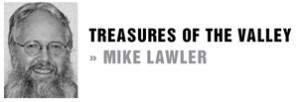I continue again with my series on the history of the land now occupied by the Verdugo Hills Golf Course, which has served as a microcosm of dynamic historic events of national caliber. Previously I conjectured the use of the land by both Indians and Spanish missions, but now we enter into the period of well recorded history.
This small valley of the Verdugo mountains was the easternmost edge of the Rancho La Cañada and, after Dr. Briggs bought the land, the easternmost parcel his sub-division of La Crescenta. It was one of the few parcels of Briggs’ land that had its own water source, and so would have been valued property. It was snapped up by the Begue family in 1882 who found (and probably ousted) on their arrival a band of displaced Indians camped on their new property. They built a rather large stone house in the canyon under a huge oak and planted vineyards.
A son of that family, Phillip Begue, was one of those dynamic early pioneers of the valley whose reminiscences have provided many of the (perhaps) tall tales that have made our local history so memorable.
Phil Begue was one of the first forest rangers of the newly established Angeles National Timberland Reserve and in his travels through CV and the San Gabriels gathered stories and legends. It was he who found the saddle and pistol discarded by the bandit Vasquez in the mountains during his last escape in 1874 from a posse that chased him up the Arroyo Seco, down Big Tujunga Canyon and later captured him in Hollywood. Begue was one of the “Coyotes,” an informal band of young bachelors that centered their free time on card playing, drinking and hunting around the Hall Ranch in La Cañada. It is also Phil Begue who is widely considered to be the one who either spread, or flat-out made up, the legend of Sister Elsie, a Catholic nun who established an Indian orphanage associated with Las Barras Canyon.
Sometime after the turn of the century, Charleston Dow bought Begue’s land. Dow was a careful diarist, and has passed down precise memories of his own, such as the fact that in the entire year of 1906 two automobiles passed his property driving along rutty Tujunga Canyon Road headed toward the Monte Vista Valley (now Sunland/Tujunga).
By the 1930s America was struggling with the Great Depression. One of the first “make work” programs of President Roosevelt’s New Deal was the establishment of the Civilian Conservation Corps. It was envisioned as a Forest Army of young men that would be assigned to remote camps for wilderness conservation work such as tree planting, road building and fire fighting. The mostly urban volunteers would be put through Army style training and would be paid $30 a month, $25 of which would be sent directly to their families. In early 1933 the Forest Service identified the need for CCC camps to be established in the Crescenta Valley for work projects in the San Gabriel and Verdugo mountains. There was one established in La Cañada in one of the canyons of the San Gabriels and another on Beaudry Road, above the Oakmont Country Club, where today a mysterious cement staircase, a sole remnant of the camp, mystifies hikers along the Beaudry fire road.
The third camp was to be on 60 acres owned by Charleston Dow and leased from Mr. Dow for $30 per month.
On May 31, 1933, 200 youths recruited from Ohio and Indiana as CCC Company 548 arrived at Las Barras Canyon to begin construction of La Tuna Camp. In typical bureaucratic fashion the camp was misnamed for the canyon next door, on the eastern side of the Verdugo mountains, effectively erasing the name of Las Barras Canyon from future maps.
Next week we’ll look at the good work these boys from La Tuna Camp performed locally, and some controversy about them.
Mike Lawler is the president of the Historical Society of the
Crescenta Valley. Reach him at lawlerdad@yahoo.com.

